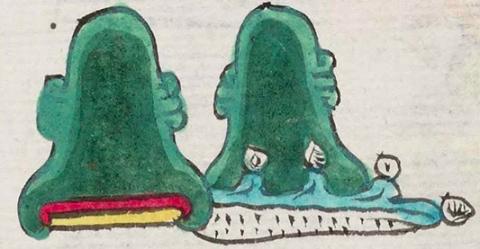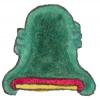Xalatlauhco (Mdz10r)
This compound glyph for the place name Xalatlauhco comprises two principal elements. One is the sand (xalli), shown in black dots below a stream of water (atl) emerging from a raving (atlauhtli). The water is a turquoise blue stream, trimmed with white turbinate shells and white water droplets/beads, that flows to the viewer's right. The ravine is created by the close placement of two hills or mountains (using the tepetl sign, which remains silent). The hills have the usual bell shape, painted a two-tone green with rocky outcroppings. The one on the left has its red and yellow horizontal stripes showing. The locative suffix (-co) is not shown visually, but perhaps the landscape provides a semantic locative.
Stephanie Wood
xalatlauhco.puo
Xalatlauhco, pueblo
Stephanie Wood
c. 1541, or by 1553 at the latest
Stephanie Wood
barrancos, arena, agua, nombres de lugares

atlauh(tli), ravine, https://nahuatl.wired-humanities.org/content/atlauhtli
xal(li), sand, https://nahuatl.wired-humanities.org/content/xalli
-co (locative suffix), in or at, https://nahuatl.wired-humanities.org/content/co
Codex Mendoza, folio 10 recto, https://digital.bodleian.ox.ac.uk/objects/2fea788e-2aa2-4f08-b6d9-648c00..., image 30 of 188.
The Bodleian Libraries, University of Oxford, hold the original manuscript, the MS. Arch. Selden. A. 1. This image is published here under the UK Creative Commons, “Attribution-NonCommercial-ShareAlike 3.0 License” (CC-BY-NC-SA 3.0).


